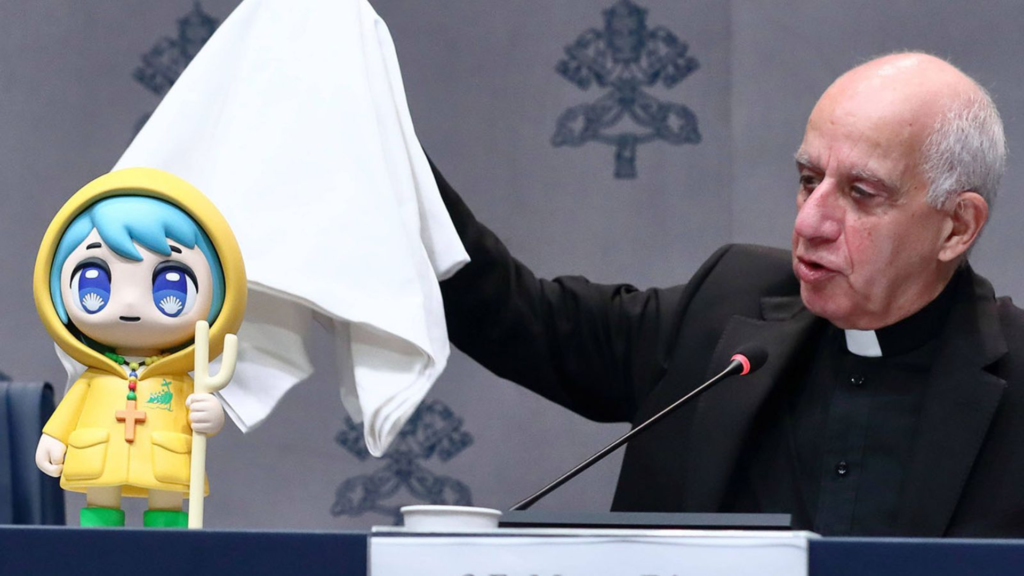
The Catholic Church is making headlines with an unexpected and bold move: it has unveiled its new anime-style mascot, Luce, in preparation for Jubilee 2025. This innovative initiative is not only a nod to modern pop culture but also a strategic effort to connect with younger generations across the globe. The introduction of Luce symbolizes a bridge between centuries-old traditions and the dynamic, visually driven world of anime—a medium that has captured the hearts and imaginations of millions worldwide.
A Beacon of Light: Who is Luce?
Luce, whose name means “light” in Italian, has been designed as a vibrant, youthful character that embodies hope, renewal, and the enduring spirit of the Church. The mascot is characterized by a striking yellow raincoat that subtly echoes the colors found in the Vatican’s own iconography. With expressive, animated features and a design that draws inspiration from contemporary anime aesthetics, Luce represents a reimagining of the Church’s image for a digital age. By adopting a look that resonates with anime fans, the Church hopes to create an approachable and relatable figure that can communicate its timeless message in a language that is both modern and visually captivating.
Embracing Modernity: The Strategic Vision
This bold venture into anime-inspired branding is part of a broader strategy by the Vatican to remain relevant in an increasingly globalized and digitally connected world. For decades, the Catholic Church has been a symbol of tradition and continuity. However, in today’s fast-paced cultural landscape, reaching out to younger audiences requires a fresh approach. With a growing number of young people around the world identifying as “otaku” or being passionate about anime, the Church sees this as an opportunity to engage with these individuals on a platform they already cherish.
Luce is not merely a mascot; she is a strategic tool intended to spark conversation and invite curiosity. The Church aims to use this new symbol to bridge the gap between its longstanding traditions and the new digital, visually-oriented era. By adopting an anime aesthetic, the Vatican is tapping into a cultural phenomenon that has transcended national boundaries, influencing not only entertainment but also fashion, art, and even language. This move signals that the Church is ready to innovate while still holding true to its core values of hope, community, and spiritual renewal.

The Unveiling Event: A Cultural Celebration
The reveal of Luce took place at a prominent pop culture event, Lucca Comics and Games, an international festival celebrated for its focus on anime, comics, and games. This setting was a deliberate choice, emphasizing the Church’s intent to engage with a community that might have previously felt disconnected from traditional religious institutions. At the event, church officials and creative teams presented Luce amid enthusiastic applause from attendees, many of whom were already well-versed in anime culture.
During the presentation, the Church’s spokesperson highlighted how Luce represents the convergence of tradition and modernity. The mascot’s design was carefully crafted to reflect themes of enlightenment and guidance—core tenets of the Church’s mission. By leveraging the universally appealing language of animation, the Vatican is not only modernizing its image but also creating a dialogue with younger audiences who consume media differently than previous generations. This dialogue is intended to foster a sense of inclusion and openness, inviting fans of anime and pop culture to explore the deeper messages of faith and community that the Church upholds

Cultural Impact: Anime’s Far-Reaching Influence
The decision to introduce an anime-style mascot is indicative of the far-reaching influence of Japanese animation and its related subcultures. Anime has long been recognized for its unique storytelling, dynamic visuals, and the ability to convey complex emotions. Over the past few decades, anime has grown from a niche interest to a dominant force in global entertainment. With blockbuster series like Attack on Titan, Demon Slayer, and Jujutsu Kaisen capturing worldwide audiences, it’s no surprise that other institutions are seeking to harness its power.
For many, anime is more than just entertainment—it is a form of art that communicates ideas and emotions in a distinctive way. The Church’s adoption of an anime-inspired mascot is a testament to the medium’s growing cultural significance. By incorporating elements of anime into its outreach, the Church acknowledges the medium’s potential to transcend traditional cultural boundaries and speak directly to the hearts of young people. In this context, Luce becomes a symbol not only of spiritual light but also of the transformative power of art and storytelling.
A New Chapter for the Church and Its Global Audience
The introduction of Luce comes at a time when many institutions are rethinking how they communicate with younger generations. With the rise of digital media and the increasing importance of social networks, traditional forms of communication are being re-evaluated. The Catholic Church, which has a rich history of art, music, and literature, is now looking to the digital canvas to tell its story in new and innovative ways.
This initiative has the potential to reshape public perception of the Church. By presenting itself in a form that is visually engaging and culturally relevant, the Vatican may succeed in demystifying aspects of its identity that some view as archaic. In doing so, it invites a broader and more diverse audience to participate in its mission. For many young people, the image of Luce might serve as an accessible entry point into a world of faith that might otherwise seem distant or unapproachable.
Moreover, Luce is poised to become a cultural ambassador—a figure that can participate in various digital and live events, merchandise lines, and interactive media projects. The versatility of an animated mascot means that the Church can integrate Luce into a wide range of outreach programs, from educational materials to social media campaigns. This multifaceted approach ensures that the message of hope and unity is delivered in a manner that is both engaging and contemporary.
Challenges and Opportunities Ahead
While the introduction of Luce has been met with enthusiasm by many, it also poses certain challenges. Critics may question whether an anime-style mascot is appropriate for an institution as venerable as the Catholic Church. There is a risk that some might perceive this move as an overly commercial or superficial attempt to modernize. However, the Church’s supporters argue that innovation is essential for staying connected in a rapidly changing world. The ultimate measure of success will be whether Luce can foster genuine engagement and inspire meaningful conversations about faith and community among young people.
Furthermore, the integration of anime culture into religious outreach represents a broader trend of cultural hybridity. As traditional boundaries between high culture and popular culture continue to blur, institutions must navigate these changes with sensitivity and creativity. The creation of Luce is a bold experiment in this space—one that, if successful, could pave the way for future initiatives that blend tradition with modern digital expression.
Conclusion: Tradition Reimagined for a Digital Age
In unveiling Luce, the Catholic Church is embracing the transformative power of anime as a means to reach new audiences and renew its message of hope. This innovative move highlights how even the most time-honored institutions can evolve by adopting new cultural expressions. Luce stands as a beacon of light—symbolizing not only spiritual guidance but also the fusion of tradition with modernity.
As the world eagerly anticipates Jubilee 2025, Luce is set to become an iconic figure, resonating with millions of young people who live in a digital era. By harnessing the universal appeal of anime, the Church is forging a new path forward—one where faith, art, and innovation converge to create a dialogue that transcends cultural and generational divides. In this bold step, tradition meets innovation, and the promise of renewal shines brightly for all.


